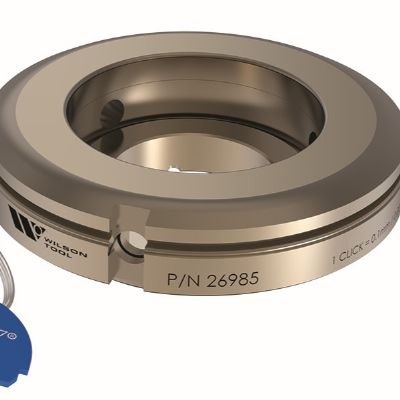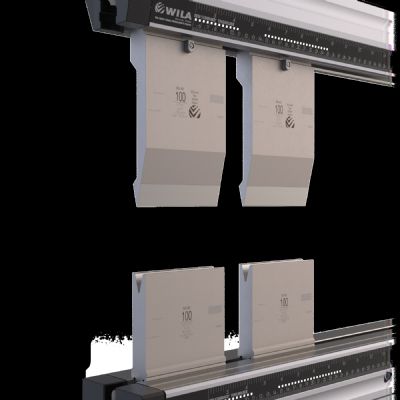To address its setup-time challenge, as well as down-skill press brake setup and operation, Diamond Metal Products recently replaced a 15-yr.-old press brake with a state-of-the-art Amada HRB 1003 model, equipped with Amada’s automatic tool changing (ATC) system. The ATC enables job change-overs in as little as 2 to 3 min.
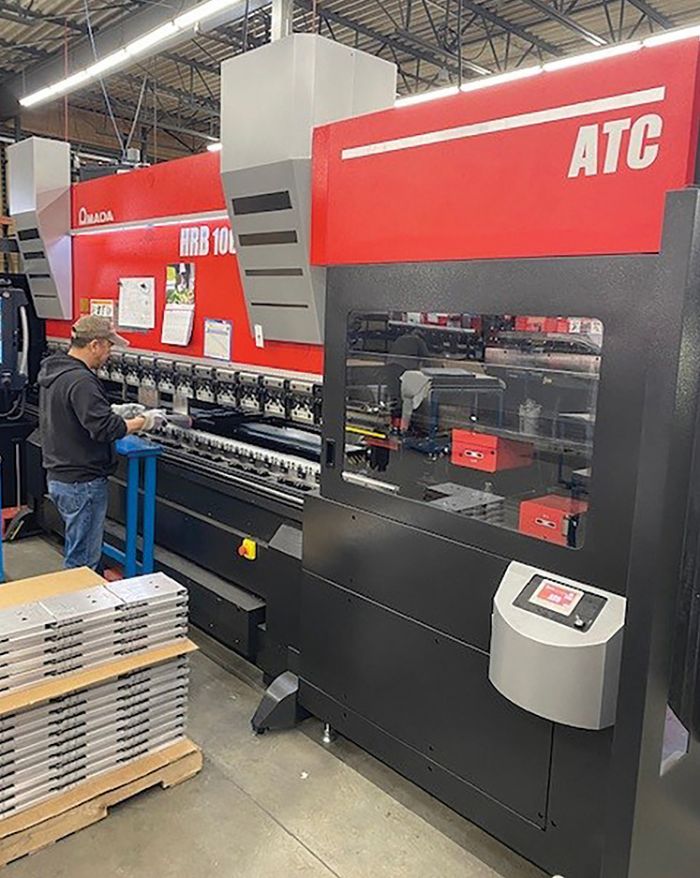 “We can run 10 times the number of jobs on this new press brake per shift compared to our other machines,” Pahl says, noting that management schedules only shorter-run production jobs of five to 50 parts on the new brake, and programs it offline so as to not interrupt production for programming.
“We can run 10 times the number of jobs on this new press brake per shift compared to our other machines,” Pahl says, noting that management schedules only shorter-run production jobs of five to 50 parts on the new brake, and programs it offline so as to not interrupt production for programming.
“Designing our processes for the press brake is a collaboration between the engineers in the office and the operators on the floor,” Pahl continues. “This collaborative process gets our people more involved and fosters teamwork, whereas before the engineers would create the flat blanks and send them to the shop where the operators would have to figure out how to form them. Now, the engineers work hand in hand with the operators to devise the most efficient bend sequences, which, I can tell you, the operators on the shop floor don’t mind at all. Yes, they still must manually set up the other machines, so they must continue to learn, but they certainly enjoy the opportunity to come into the office and help with programming. I feel like these blue-collar positions, then, are evolving more into white-collar jobs.
“And, that collaboration,” adds Pahl, “noticeably has streamlined the time it takes to achieve first-part quality objectives. In effect, we’ve moved nearly all of the required expertise in press brake and tooling setup to the engineering and programming office, and have allowed our operators to focus on handling the material. The impact on productivity is significant.”
Controller Interface an Operator’s Best Friend
 The HRB 1003 press brake itself (rated to 110 tons, with a 10-ft. maximum bend length, 9.8-in. stroke and 27.5-in. backgauge range) boasts several useful, productivity-enhancing features as standard, including a control with a built-in barcode reader, six-axis backgauge system, adjustable crowning and three-position foot pedal, “a particularly useful feature that our operators really appreciate,” Pahl notes, “during stage bending where we set up multiple tools along the bed of the machine. We really try to form complete parts in one cycle on the press brake, using a progressive-die setup, and the operators appreciate not having to drag the foot pedal along the floor.
The HRB 1003 press brake itself (rated to 110 tons, with a 10-ft. maximum bend length, 9.8-in. stroke and 27.5-in. backgauge range) boasts several useful, productivity-enhancing features as standard, including a control with a built-in barcode reader, six-axis backgauge system, adjustable crowning and three-position foot pedal, “a particularly useful feature that our operators really appreciate,” Pahl notes, “during stage bending where we set up multiple tools along the bed of the machine. We really try to form complete parts in one cycle on the press brake, using a progressive-die setup, and the operators appreciate not having to drag the foot pedal along the floor.
“In addition,” Pahl says, “the graphical interface on the controller displays each move in the bend sequence to help guide the operator during multistage bending.”
The firm’s optimum workpiece size, explains Pahl, is anything less than a 2-ft. square—“there’s no need for a sheet follower,” he says. “In the past we have taken on larger parts but now shy away from that work for ergonomic concerns. Staying within that 2-ft. window—and we have plenty of work that fits that bill—is much easier on our team.”
Training a Breeze
In terms of training the workforce to work with the new press brake, “Amada recommends that you take your top press brake operator and turn him into the programmer,” Pahl says. “We also had Amada train our engineer in programming. Training really was quick and simple, as the touchscreen’s machine control is very user-friendly. Training took just a few days; I think our team caught on very quickly.”
The ATC features multi-axis manipulators that pick and place punches and dies from the machine’s tool magazine based on the part-bending program uploaded into the machine control from the engineering office. As the machine requires custom tooling to enable automatic tool changes, Diamond Metal Products ordered all new tooling for the HRB 1003 ATC, “after Amada came in and looked at the types of jobs we’d be running through it. Right now, about 90 percent of what we fabricate can run on that machine as currently outfitted with tooling, and we still have some allowance remaining to add more tooling. The ATC is about 75-percent full. But being at 90 percent is huge for us, even if we don’t yet run that much work through the press brake.”
One additional benefit of the ATC touted by Pahl: setup repeatability. Operators manually loading tooling may not place the tooling in exactly the same place along the machine bed from one setup to the next, Pahl says. “That affects part-dimension repeatability,” he explains. “Now when we program a job, we know with certainty that the ATC will load and position the tooling repeatedly in the brake time after time.
“If I were starting a metal-fabrication shop from scratch, I would have no problem launching production with this ATC brake,” Pahl adds, “especially when expecting to take on a lot of short-run work. The ATC is a game changer.” MF
View Glossary of Metalforming Terms
See also: AMADA Press System America Inc
Technologies: Bending
Comments
Must be logged in to post a comment. Sign in or Create an Account
There are no comments posted.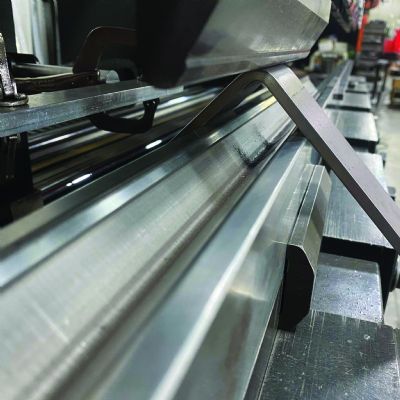 Bending
BendingCreative Approaches to Common Press Brake Challenges, Part 4...
Justin Talianek April 25, 2025







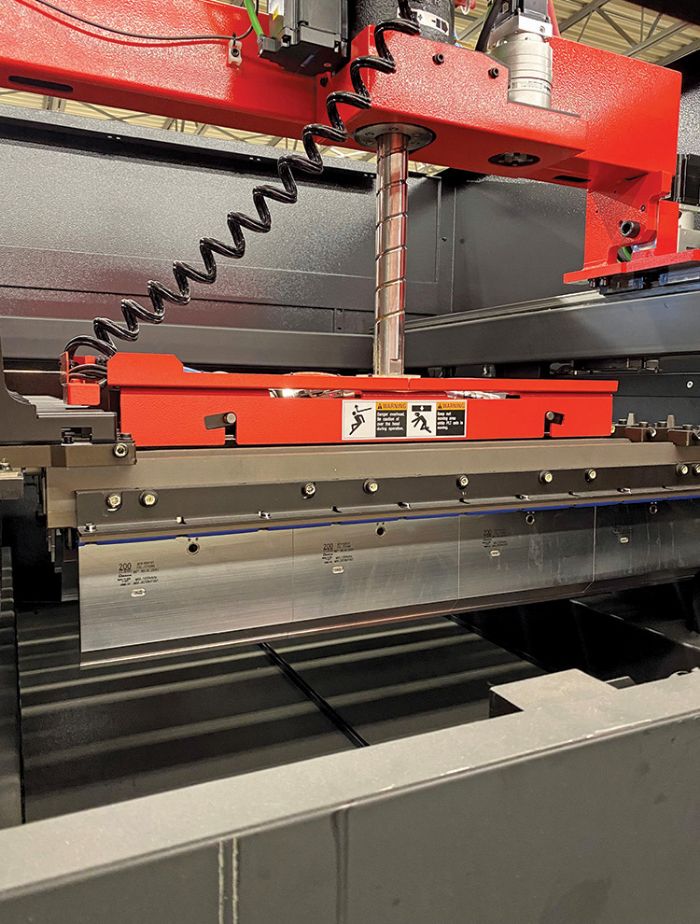 A recent focus along these lines for the company: reducing setup times among its press brake operations. The firm’s 40,000-sq.-ft. sheet metal-fabrication facility (it also operates a 10,000-sq.-ft. machine shop across the street) is home to 10 press brakes, along with CNC turret punch presses, waterjet and laser cutting machines, welding equipment and more.
A recent focus along these lines for the company: reducing setup times among its press brake operations. The firm’s 40,000-sq.-ft. sheet metal-fabrication facility (it also operates a 10,000-sq.-ft. machine shop across the street) is home to 10 press brakes, along with CNC turret punch presses, waterjet and laser cutting machines, welding equipment and more.